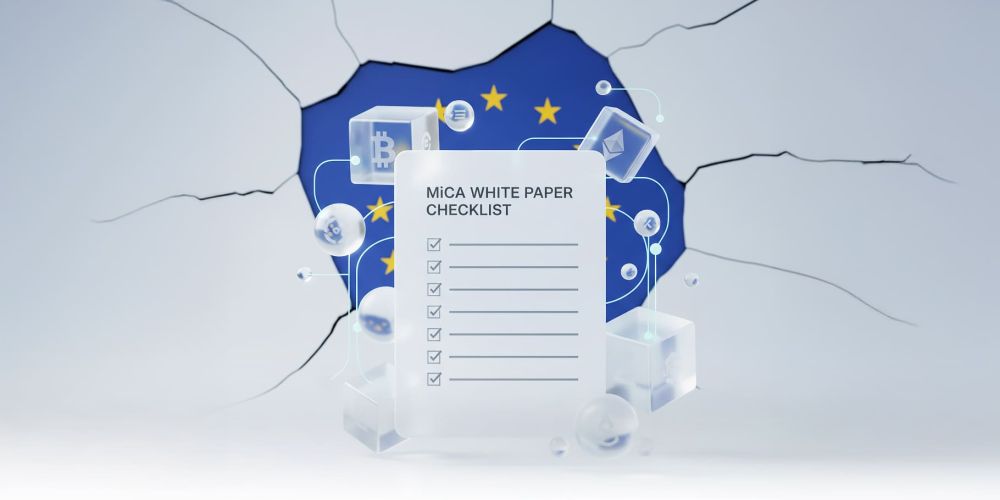MiCA White Paper Checklist: Structure, Risks, and Legal Essentials

When the MiCA regulation finally stepped into the spotlight, many crypto founders realised the industry had entered a new chapter. Not the kind with loud headlines and fear-driven commentary, but a quieter, more mature phase — where clarity replaces guesswork and where a white paper is no longer a marketing document but a regulated disclosure.
If you’re preparing to launch a token in the EU, your White Paper isn’t just a PDF someone uploads to a website. Under MiCA, it becomes a legal statement — one that shapes your responsibility as an issuer and the level of trust your project receives.
This guide breaks down the essential elements of a MiCA-compliant White Paper in a simple, practical way. No jargon, no legalese overload — just the information founders actually need.
What MiCA Wants From Your White Paper
MiCA is surprisingly straightforward about its expectations. The regulation wants one thing above all: transparency. Not idealised promises. Not glossy roadmaps. Transparency.
A compliant White Paper must help a reader understand three things:
- What the token is?
- How the project works?
- What risks a buyer is taking?
If your document honestly answers those three questions — and does so in the right structure — you’re already halfway there.
The Core Structure of a MiCA White Paper
You can think of a MiCA White Paper as a well-organized story about your project, where each chapter has a clear purpose. Here’s the structure most founders follow to stay compliant:
1. Summary of the Offering
A brief and clear explanation of what you are offering and why. Avoid technical jargon — the goal is clarity, not complexity.
2. Description of the Issuer
Who you are, where you’re based, and what you do. This section should read like a factual introduction, not a pitch deck.
3. Description of the Project / Protocol
This is where you show how your system operates. Explain:
- The business model;
- The architecture;
- What role the token plays;
- How the system generates value (if applicable).
4. Complete Token Overview
MiCA wants you to be very clear about the asset you’re issuing:
- Token type;
- Technology used;
- Rights (or lack of rights);
- Utility;
- Transferability;
- Supply;
- Distribution model;
- Vesting, lockups, cliffs;
- Burn/mint mechanics, if any.
No hidden details — everything must be transparent.
5. Rights and Obligations of Holders
The reader must understand one simple point: “What am I actually buying?”
If the token does not represent ownership, dividends, or governance — this must be stated plainly.
6. Risk Factors
This is not the “boring section” everyone scrolls past. Under MiCA, this is a legally meaningful part of your document.
Risks typically include:
- Technology vulnerabilities;
- Liquidity concerns;
- Market risks;
- Team-related issues;
- Regulatory risks;
- Smart-contract failures;
- Operational failures;
- Third-party dependencies;
This part shows honesty — and regulators expect honesty.
7. Use of Funds
If funds are raised, the White Paper must explain how they will be used. No vague statements like “product development.” MiCA prefers specifics.
8. Marketing Disclaimer
A White Paper is not financial advice. It is not an investment prospectus. You must clearly say this — and explain the limitations.
The Legal Essentials You Cannot Miss
While MiCA is not as strict as securities law, it still imposes concrete obligations on founders. Here are the key points:
Liability
Once you publish the White Paper, you are legally responsible for its accuracy. If it contains misleading statements or omits critical information, the issuer can be held liable.
Consumer Protection
The buyer must understand what they are getting into. This means simple language, clear explanations, and no marketing wordplay that disguises risk.
Notifications to the Regulator
For many tokens (excluding EMT and ART categories), you only need to notify, not seek approval. But the notification must be complete — missing details can escalate into serious issues.
Public Availability
The White Paper must be accessible to the public in a durable format. If you later update it, the changes must be visible.
The Most Common Mistakes Founders Make
Working with Web3 teams since 2016, we’ve seen a pattern of recurring errors. Here are the ones that often derail compliance:
-
Over-marketing the document
A MiCA White Paper is not a pitch. It’s a regulated disclosure.
-
Hiding or minimizing risks
Some founders fear that listing risks “scares users.” In reality, it builds trust — and it’s required by law.
-
Ignoring token economics transparency
Complex, vague, or inconsistent tokenomics is a red flag for regulators and exchanges.
-
Copy-pasting old white papers
MiCA White Papers follow a specific structure.Deck-style “Web3 white papers” no longer work.
-
Misclassifying the token
Many founders assume they issue a “utility token,” while in reality the structure says otherwise.
Why a Strong MiCA White Paper Helps Beyond Compliance
A well-structured White Paper does more than keep regulators satisfied. It also:
-
Builds trust with users;
-
Elevates your reputation among partners;
-
Increases listing chances on major exchanges;
-
Reduces legal exposure for founders;
-
Shows maturity in a competitive market.
In essence, it becomes the foundation of your public credibility.
Final Thoughts: Treat Your White Paper Like a Legal Asset
MiCA isn’t here to slow down Web3 — it’s here to prevent chaos. A clean, transparent, well-built White Paper signals that your project is serious. It shows that you’re ready for large audiences, regulated environments, and long-term growth.
Whether you’re building a DeFi protocol, a utility token, or a next-generation appchain, one thing remains constant: your White Paper will be judged. By users, by partners, by exchanges — and sometimes by regulators.
Make it strong. Make it honest. Make it professional.
And if you need help reviewing, structuring, or preparing a MiCA-ready White Paper, the Legal Kornet team is always here to support you.


